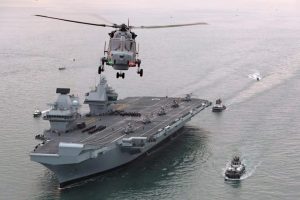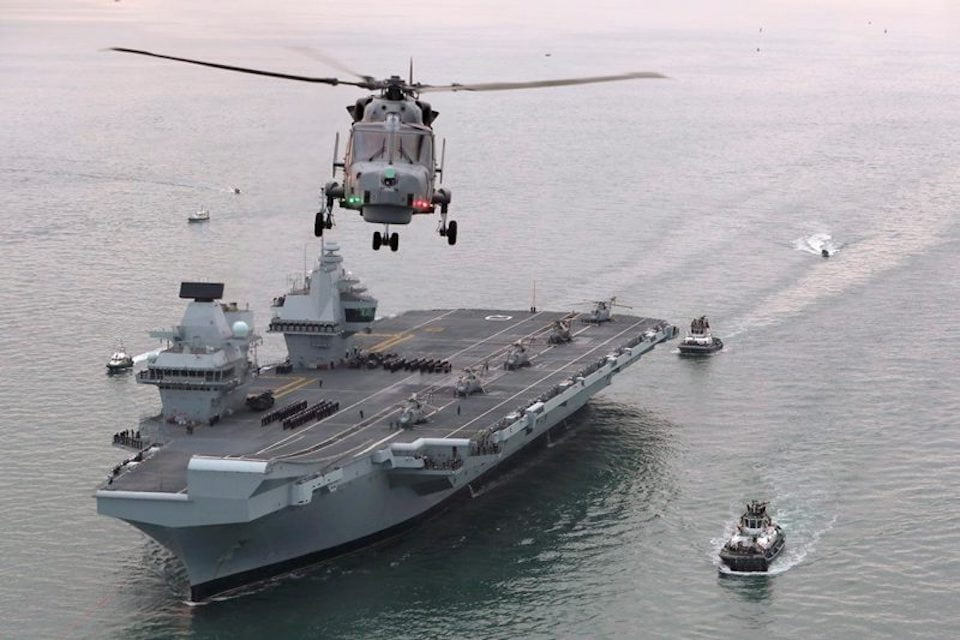2017-11-20 The new Queen Elizabeth class carrier is the largest warship ever built in the United Kingdom.
While most of the focus of the press coverage has been on the process of building the carrier and now its sea trials, the carrier is coming at a very interesting point in British history.
There is a clear need to shape a post-Brexit defense policy, and having a significant epicenter of national sovereignty able to operate throughout the region and beyond certainly can be worked into that as yet to be written policy narrative.
HMS Queen Elizabeth is currently on sea trials off the south coast of England.. Credit: UK Ministry of Defence
This narrative has begun to be written and was articulated as follows by the new defense minister in his visit onboard the ship earlier this month:
“This is very much about how Britain can project its influence and its power right across the world,” Mr. Williamson said.
“It is how we can say to the rest of the world, we are not a nation in retreat, we are a nation that wishes to play a significant part in world affairs.”
But it also also at the heart of integrating UK forces to deliver UK capabilities within the integrated battlespace, both in terms of an integrated carrier strike force as well as in terms of shaping the various war fighting systems which will come together onboard the ship.
It is however at the heart of shaping 21st century interoperability.
There is the interoperability being worked with the US Navy, as evidenced in the recent Saxon Warrior exercise off of Scotland.
There is the interoperability being worked as the USMC will operate its F-35Bs off of the ship.
This will require an ability for the ship to operate US weapons onboard as well as to accommodate USMC maintainers as well with their specific national maintenance approaches.
The ship is an F-35 carrier and will work its interoperability with other F-35s as well in the region, notably with the Dutch, the Norwegians, the Danes, the Italians, the Israelis, the US and perhaps others Europeans as well.
In other words, the carrier is at the vortex of a turn in British history, and a key element of shaping 21st century force integration and interoperability.
In an article published on the UK Ministry of Defence website on November 16, 2017, the forthcoming commissioning by the Queen was highlighted.
Her Majesty the Queen will formally commission her namesake aircraft carrier, HMS Queen Elizabeth, into the Royal Navy fleet in just three weeks’ time.
Defence Secretary Gavin Williamson announced the news as he made his first landing onto the deck of the carrier today, while she was at sea sailing around the South Coast of England.
Defence Secretary Gavin Williamson said:
“In a world of intensifying global threats, this magnificent ship will be a leading force fighting to protect the values of the UK and our allies. It’s an honour to visit her at sea, and to meet such a passionate crew. I’m sure Her Majesty will be similarly impressed at next month’s historic ceremony for the nation’s new flagship, which proudly bears her name.
“The carrier is currently making great progress through her sea trials and will return to her home port in Portsmouth in a few weeks’ time. Her Majesty the Queen will then visit the ship in Portsmouth on 7 December for the formal commissioning ceremony.”
Her Majesty will be joined by a host of dignitaries from the Royal Family, Government and the military, before saying a few words as Lady Sponsor. The commissioning warrant will then be read and the White Ensign raised, symbolising the acceptance of HMS Queen Elizabeth into Her Majesty’s fleet.
It will be the first time Her Majesty the Queen has visited the UK’s new flagship since she formally named her in Rosyth, Scotland in July 2014.
Since then the ship has been completed, sailed into her home dock of Portsmouth for the first time and is now continuing her sea trials. Her identical sister ship, HMS Prince of Wales, has also been formally named and is now structurally complete.
The Defence Secretary took a Merlin helicopter from RAF Northolt and landed on the flight-deck this morning, where he met the ship’s company, from the Captain Jerry Kyd to the most junior ranks.
 HMS Queen Elizabeth is currently on sea trials off the south coast of England.. Credit: UK Ministry of Defence
HMS Queen Elizabeth is currently on sea trials off the south coast of England.. Credit: UK Ministry of Defence
Captain Jerry Kyd said:
“I was delighted to be able to welcome the Defence Secretary on board HMS Queen Elizabeth at what is a very exciting time for the ship, for the Royal Navy, and for Defence as we move into the final phase of our sea trials.
“We spoke about the progress made on our trials so far and the exciting future ahead as the UK regenerates its strike carrier capability.
“We’re glad the Defence Secretary took the time to visit us and really get under the skin of this aircraft carrier and see for himself the enormous potential of this ship that will be deployed across the globe for the next half century.”
Both of the UK’s aircraft carriers are being delivered by the Aircraft Carrier Alliance, a unique partnering relationship between industry and the UK Ministry of Defence.
The recent exercise Saxon Warrior saw the participation of both the Queen Elizabeth and the George H.W. Bush carriers.
According to an article published in Naval Today at the conclusion of the exercise:
The joint US-UK exercise Saxon Warrior, held in waters off Scotland, concluded on August 10 after ten days of drills.
Surface combatants from the UK, US and Norway joined the US Navy aircraft carrier USS George H.W. Bush as the Royal Navy is preparing to revive its carrier strike capability.
At one point of the exercise, the international group was joined by the Royal Navy’s new aircraft carrier Queen Elizabeth for a photo opportunityand a group sail, just days ahead of her commissioning in Portsmouth.
As the Royal Navy explained, the exercise in broad terms involved a notional conflict between neighboring countries, one of which is Pastonia, supported by a multinational naval force, Carrier Strike Group (CSG) 315.01.
The CSG included Type 23 frigates HMS Westminster and Iron Duke, Norwegian frigate Helge Ingstad, United States ships USS Philippine Sea and Donald Cook, and the supercarrier George Bush (GHWB). Opposing this strike group was Task Force 606 of the Dragonian Navy composed of US destroyer USS Truxton and cruiser Leyte Gulf, led by the Norwegian frigate Otto Sverdrup.
There were also a large number of other elements to the exercise including supporting aircraft providing air raids, plus 29 Commando and Swedish tactical air controllers providing forward observation to ships and aircraft dropping ordnance onto Cape Wrath.
The air participants included Navy and RAF Hawk aircraft, RAF Typhoons, a large number of United States carrier borne aircraft which are mostly F18 Super Hornets, as well as British, American and German surveillance and refueling aircraft.
On-board GHWB were staff from the UK Carrier Strike Group brushing up their skills for the arrival of aircraft on-board our own supercarrier HMS Queen Elizabeth.
“Exercise Saxon Warrior is an incredibly important and exciting step in the regeneration of the UK’s Carrier Strike capability,” said JTEPS commander Captain Andrew Stacey RN.
“The generosity of the United States Navy in the provision of not only a Carrier Strike Group but also mentoring and exercise enablers has been crucial in ensuring that Royal Navy is on the right path to stand shoulder to shoulder with the USN with a shared Carrier Strike heritage.”


